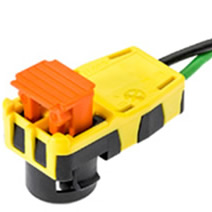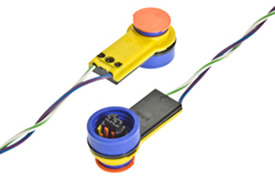A Connector Can Save Your Life
 A Connector Can Save Your Life
A Connector Can Save Your Life
It takes less than 50 milliseconds for an airbag to inflate. Because your life can depend on that spark of time, automotive designers, as well as component designers, are coordinating their technology innovations to work in concert with these critical systems.
Safety Restraint Systems (SRS) connectors, which are used to connect wiring to pyrotechnic devices such as airbags, belt pre-tensioners, knee bolsters, and pedestrian safety devices, aid in the protection of vehicle passengers.
Specific connectors for automotive safety restraints have been developed to fit various requirements, such as space limitations, harsh environments, and different electromagnetic noise-suppression standards. The main function is to ensure a stable electrical connection over the lifetime of the vehicle while assisting the assembly worker with an ergonomic mating system. One mission-critical feature is the filtering of unwanted electrical spikes to avoid misfiring of an airbag.
The worldwide market for airbags and other safety restraint systems is mostly limited to a number of distinct geographic regions, each with its own characteristics and requirements. Germany was the first to see the airbag arrive in mass production cars, in the 1981 Mercedes-Benz. In the late 1980s, Porsche and Honda, in Japanese models, introduced models with airbags. In 1988, Chysler began to offer the equipment in some models, the first widespread use of the airbag in North America. It was not until the 1990s that airbags became widespread in North America. The Western European market, in contrast, was relatively slow to adopt the airbag. Despite this, from the 1990s onwards, their use in Europe has grown rapidly, to the point that their use is now more prevalent than in North America. In particular, the increased focus on vehicle occupant safety has spurred a proliferation in the number of airbags fitted, even to low-cost, entry-level models. Typically, these now include multiple passenger, side, curtain, and knee bags. Up to 30 pyrotechnic devices can now be found in luxury car models in Western Europe.
In the fast-developing countries, relatively fewer cars are equipped with safety features. Airbags tend to be limited to basic driver and possibly front passenger applications. Similarly, seatbelts are more likely to feature mechanical rather than pyrotechnical restraining systems. Despite the weaker public interest and lower technological levels, these emerging markets nonetheless account for a large part of the international market and can experience impressive growth.
 Brazil recently enacted safety legislation, and the effects on the market have already been dramatic. The government has mandated airbags in every vehicle by 2012, raising frontal airbag penetration from less than 10% to 100% in just four years.
Brazil recently enacted safety legislation, and the effects on the market have already been dramatic. The government has mandated airbags in every vehicle by 2012, raising frontal airbag penetration from less than 10% to 100% in just four years.
The Chinese market is growing astonishingly fast, simply because more people are buying cars. NCAP (New Car Assessment Programme) test requirements are helping to increase airbag penetration. While earlier generations of car buyers tended to focus mainly on exterior styling, today’s buyers are paying more attention to safety features and the overall driving experience. Rising customer concerns over vehicle safety is also contributing to this growth. Chinese vehicle manufacturers tend to adopt more advanced safety systems into a wider range of passenger vehicle segments to differentiate their products in this highly competitive market.
Delphi introduced the first airbag into the market in 1973, but as the automotive market is migrating to the next generation of interface standards, the entire automotive connector market is working on the next safety innovation, to keep up with the foremost concerns of today’s car buyers.
Delphi has created the current global AK-2 standard, which has been adopted by ISO and is now being rolled out by all major OEMs. Increasing amounts of safety features in current vehicles drive the overall volume and bring airbags to new environments, such as the engine compartment. This contributes to the development of improved squib designs.
By Mika Arpe, Director Global Product Line Management, Safety Restraint Systems, Delphi Automotive

